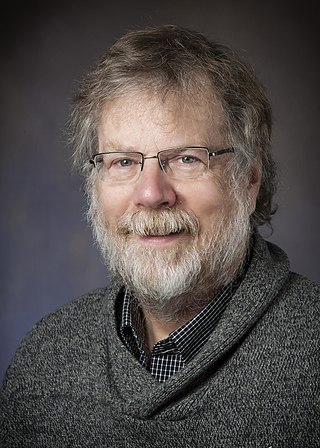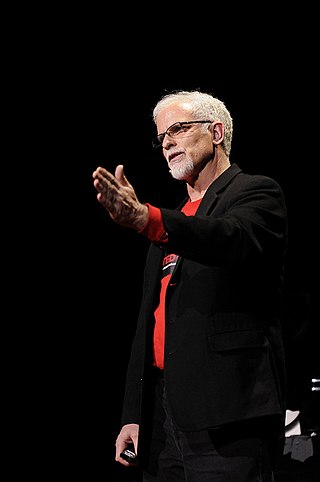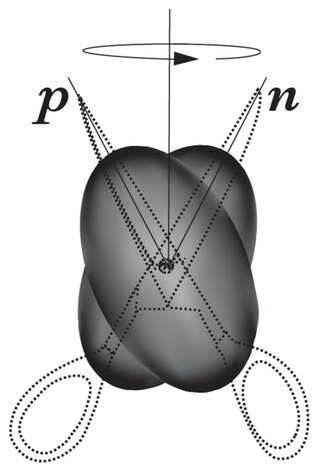Related Research Articles

In physics, topological order is a kind of order in the zero-temperature phase of matter. Macroscopically, topological order is defined and described by robust ground state degeneracy and quantized non-Abelian geometric phases of degenerate ground states. Microscopically, topological orders correspond to patterns of long-range quantum entanglement. States with different topological orders cannot change into each other without a phase transition.

Édouard Brézin is a French theoretical physicist. He is professor at Université Paris 6, working at the laboratory for theoretical physics (LPT) of the École Normale Supérieure since 1986.
Oleg Sushkov is a professor at the University of New South Wales and a leader in the field of high temperature super-conductors. Educated in Russia in quantum mechanics and nuclear physics, he now teaches in Australia.
Jozef T. Devreese is a Belgian scientist, with a long career in condensed matter physics. He is Professor Emeritus of Theoretical Physics at the University of Antwerp.

In condensed matter physics, a string-net is an extended object whose collective behavior has been proposed as a physical mechanism for topological order by Michael A. Levin and Xiao-Gang Wen. A particular string-net model may involve only closed loops; or networks of oriented, labeled strings obeying branching rules given by some gauge group; or still more general networks.
Atomtronics is the emerging quantum technology of matter-wave circuits which coherently guide propagating ultra-cold atoms. The systems typically include components analogous to those found in electronic or optical systems, such as beam splitters and transistors. Applications range from studies of fundamental physics to the development of practical devices.
The topological entanglement entropy or topological entropy, usually denoted by , is a number characterizing many-body states that possess topological order.
Quantum dimer models were introduced to model the physics of resonating valence bond (RVB) states in lattice spin systems. The only degrees of freedom retained from the motivating spin systems are the valence bonds, represented as dimers which live on the lattice bonds. In typical dimer models, the dimers do not overlap.

Xiao-Gang Wen is a Chinese-American physicist. He is a Cecil and Ida Green Professor of Physics at the Massachusetts Institute of Technology and Distinguished Visiting Research Chair at the Perimeter Institute for Theoretical Physics. His expertise is in condensed matter theory in strongly correlated electronic systems. In Oct. 2016, he was awarded the Oliver E. Buckley Condensed Matter Prize.

David Matthew Ceperley is a theoretical physicist in the physics department at the University of Illinois Urbana-Champaign or UIUC. He is a world expert in the area of Quantum Monte Carlo computations, a method of calculation that is generally recognised to provide accurate quantitative results for many-body problems described by quantum mechanics.
Subir Sachdev is Herchel Smith Professor of Physics at Harvard University specializing in condensed matter. He was elected to the U.S. National Academy of Sciences in 2014, and received the Lars Onsager Prize from the American Physical Society and the Dirac Medal from the ICTP in 2018. He was a co-editor of the Annual Review of Condensed Matter Physics from 2017-2019.
A composite fermion is the topological bound state of an electron and an even number of quantized vortices, sometimes visually pictured as the bound state of an electron and, attached, an even number of magnetic flux quanta. Composite fermions were originally envisioned in the context of the fractional quantum Hall effect, but subsequently took on a life of their own, exhibiting many other consequences and phenomena.
Daniel L. Stein is an American physicist and Professor of Physics and Mathematics at New York University. From 2006 to 2012 he served as the NYU Dean of Science.
Eric R. Weeks is an American physicist. He completed his B.Sc. at the University of Illinois at Urbana–Champaign in 1992. He obtained a Ph.D. in physics from the University of Texas at Austin in 1997, working under Harry Swinney, and later completed post-doctoral research with David Weitz and Arjun Yodh at Harvard University and the University of Pennsylvania. He is currently a full professor at Emory University in Atlanta, Georgia.
Philippe Guyot-Sionnest is a professor at the University of Chicago appointed jointly in the departments of physics and chemistry. He works in the field of colloidal semiconductors and metal nanocrystals.

Michael Lee Roukes is an American experimental physicist, nanoscientist, and the Frank J. Roshek Professor of Physics, Applied Physics, and Bioengineering at the California Institute of Technology (Caltech).
Erwin Gabathuler was a particle physicist from Northern Ireland.
In quantum many-body physics, topological degeneracy is a phenomenon in which the ground state of a gapped many-body Hamiltonian becomes degenerate in the limit of large system size such that the degeneracy cannot be lifted by any local perturbations.

Scissors Modes are collective excitations in which two particle systems move with respect to each other conserving their shape. For the first time they were predicted to occur in deformed atomic nuclei by N. LoIudice and F. Palumbo, who used a semiclassical Two Rotor Model, whose solution required a realization of the O(4) algebra that was not known in mathematics. In this model protons and neutrons were assumed to form two interacting rotors to be identified with the blades of scissors. Their relative motion (Fig.1) generates a magnetic dipole moment whose coupling with the electromagnetic field provides the signature of the mode.
Bogdan Andrei Bernevig is a Romanian Quantum Condensed Matter Professor of Physics at Princeton University and the recipient of the John Simon Guggenheim Fellowship in 2017.
References
- ↑ "Annual Review of Condensed Matter Physics, Planning Editorial Committee - Volume 5, 2014". Annual Reviews Directory. Retrieved 14 September 2021.
- ↑ "Annual Review of Condensed Matter Physics, Planning Editorial Committee - Volume 8, 2017". Annual Reviews Directory. Retrieved 14 September 2021.
- ↑ Willett, R; Eisenstein, J. P; Störmer, H. L; Tsui, D. C; Gossard, A. C; English, J. H (1987). "Observation of an even-denominator quantum number in the fractional quantum Hall effect" (PDF). Physical Review Letters. 59 (15): 1776–1779. Bibcode:1987PhRvL..59.1776W. doi:10.1103/PhysRevLett.59.1776. PMID 10035326.
- ↑ Girvin, Steven M (1999). "The Quantum Hall Effect: Novel Excitations and Broken Symmetries". Topological Aspects of Low Dimensional Systems, ed. A. Comtet, T. Jolicoeur, S. Ouvry, F. David (Springer-Verlag, Berlin and les Editions de Physique, les Ulis, ). 2000. arXiv: cond-mat/9907002 . Bibcode:1999tald.conf...53G.
- ↑ Moore, Gregory; Read, Nicholas (1991). "Nonabelions in the fractional quantum hall effect". Nuclear Physics B. 360 (2–3): 362. Bibcode:1991NuPhB.360..362M. doi: 10.1016/0550-3213(91)90407-O .